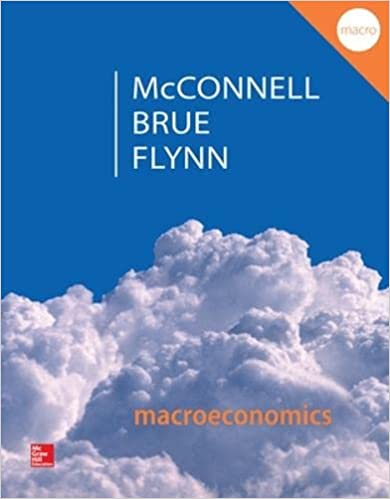
Macroeconomics 20th Edition by Campbell McConnell ,Stanley Brue ,Sean Flynn
Edition 20ISBN: 978-0077660772
Macroeconomics 20th Edition by Campbell McConnell ,Stanley Brue ,Sean Flynn
Edition 20ISBN: 978-0077660772 Exercise 22
Suppose initially that two assets, A and B, will each make a single guaranteed payment of $100 in 1 year. But asset A has a current price of $80 while asset B has a current price of $90. LO3
a. What are the rates of return of assets A and B at their current prices? Given these rates of return, which asset should investors buy and which asset should they sell?
b. Assume that arbitrage continues until A and B have the same expected rate of return. When arbitrage ends, will A and B have the same price?
Next, consider another pair of assets, C and D. Asset C will make a single payment of $150 in one year while D will make a single payment of $200 in one year. Assume that the current price of C is $120 and that the current price of D is $180.
c. What are the rates of return of assets C and D at their current prices? Given these rates of return, which asset should investors buy and which asset should they sell?
d. Assume that arbitrage continues until C and D have the same expected rate of return. When arbitrage ends, will C and D have the same price?
Compare your answers to questions a through d before answering question e.
e. We know that arbitrage will equalize rates of return. Does it also guarantee to equalize prices? In what situations will it equalize prices?
a. What are the rates of return of assets A and B at their current prices? Given these rates of return, which asset should investors buy and which asset should they sell?
b. Assume that arbitrage continues until A and B have the same expected rate of return. When arbitrage ends, will A and B have the same price?
Next, consider another pair of assets, C and D. Asset C will make a single payment of $150 in one year while D will make a single payment of $200 in one year. Assume that the current price of C is $120 and that the current price of D is $180.
c. What are the rates of return of assets C and D at their current prices? Given these rates of return, which asset should investors buy and which asset should they sell?
d. Assume that arbitrage continues until C and D have the same expected rate of return. When arbitrage ends, will C and D have the same price?
Compare your answers to questions a through d before answering question e.
e. We know that arbitrage will equalize rates of return. Does it also guarantee to equalize prices? In what situations will it equalize prices?
Explanation
a. The return of A ( r A ) and the retur...
Macroeconomics 20th Edition by Campbell McConnell ,Stanley Brue ,Sean Flynn
Why don’t you like this exercise?
Other Minimum 8 character and maximum 255 character
Character 255


